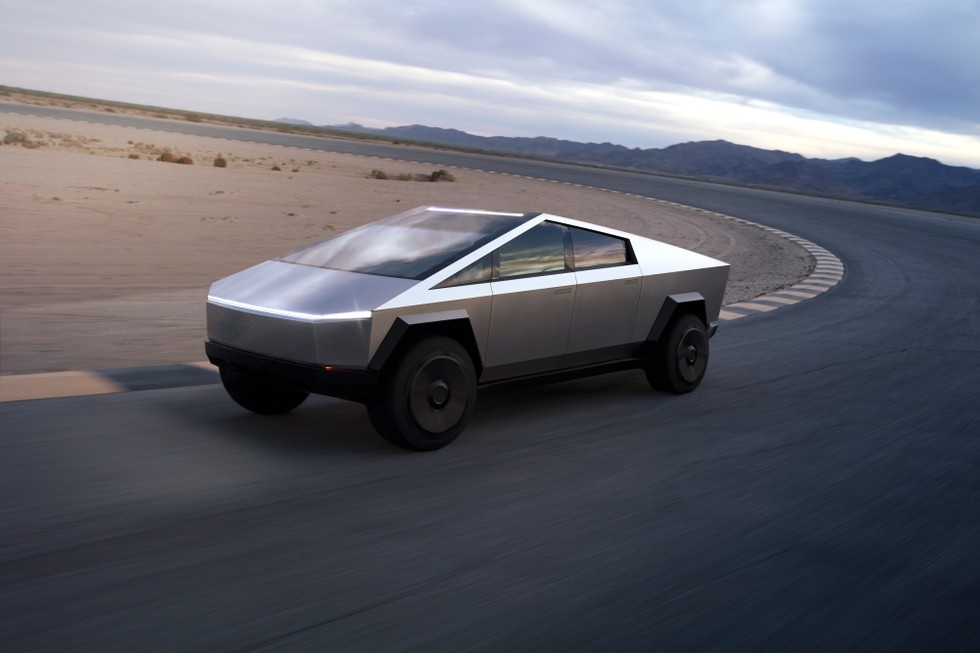The automotive world is in constant flux. Each year brings a wave of innovation, propelling our vehicles forward with cutting-edge technology, refined functionalities, and groundbreaking designs. But what does the horizon hold for Futuristic Cars? Are we on the cusp of unprecedented advancements, or have we already reached the pinnacle of automotive design? Let’s delve into the exciting realm of future car technology, concept vehicles, and forthcoming models that are set to redefine our driving experience.
Tesla Cybertruck: A Bold Step into the Future
No conversation about futuristic cars is complete without mentioning Tesla’s Cybertruck. This polarizing vehicle, initially revealed in 2019, has become synonymous with futuristic automotive design, despite facing repeated delays, with a current target launch in 2023.
The Cybertruck’s core philosophy revolves around resilience. Its exoskeleton is constructed from Ultra-Hard 30X Cold-Rolled stainless steel, resulting in an exceptionally robust frame. This unique material choice dictates the vehicle’s sharp, angular aesthetic, as cold-rolled metal inherently lacks flexibility in shaping. The robust stainless-steel frame of the Cybertruck is a hallmark of its futuristic and durable design.
Despite an infamous demonstration mishap where its windows were unexpectedly damaged, Tesla asserts the Cybertruck’s strength extends to its glass. They claim that ultra-strong glass and polymer-layered composite will effectively dissipate and redirect impact forces, ensuring window integrity. The promise of unbreakable windows adds to the futuristic appeal and durability claims of the Tesla Cybertruck.
Tesla further boasts the Cybertruck’s towing capacity exceeding 6,350 kilograms – comparable to the weight of an African bush elephant. These impressive specifications are ambitious, and given the vehicle’s history of delays, the question remains whether the Cybertruck will truly materialize in 2023 and live up to its futuristic promises.
BMW iX Flow: The Chameleon Car
BMW’s iX Flow, unveiled at CES 2022, might initially appear conventional, blending seamlessly into everyday traffic. However, this futuristic car conceals a remarkable feature: it can change color at the touch of a button.
This color transformation is achieved through a color-swapping e-ink ‘paint’. Essentially, the car’s exterior is coated in a vast e-reader display comprising millions of microcapsules filled with pigments. Each capsule contains negatively charged white pigments and positively charged black pigments. By altering an electrical field, the desired pigment rises to the surface, changing the car’s color. This innovative e-ink technology is at the heart of the BMW iX Flow’s futuristic color-changing capability.
The color shift isn’t limited to the entire vehicle. BMW showcased dynamic racing stripes, multi-colored patterns, and seamless transitions between black and white across the car’s surface. The customizable exterior color of the BMW iX Flow represents a futuristic leap in car personalization.
While reminiscent of vehicles from a James Bond film, the iX Flow is currently a concept. BMW’s decision to commercialize this technology remains uncertain, and questions linger regarding the durability of the microcapsule system in real-world driving conditions.
Meta Materials HUD: Holographic Heads-Up Display
Heads-Up Displays (HUDs) are a staple of science fiction, consistently depicted as a key element of futuristic cars. At CES 2022, Meta Materials presented their version of this technology, employing holography to project crucial driving information directly within the driver’s line of sight. Meta Materials argues this approach enhances driver focus by eliminating the need to glance down at instrument panels.
A HUD system minimizes eye adjustments between the road and in-car instruments, potentially improving driver reaction times by maintaining constant road awareness. Projecting critical information directly onto the windshield is a key feature of futuristic car HUD technology. However, like many advanced automotive technologies, widespread adoption of holographic HUDs is still in the future, requiring rigorous testing and regulatory approvals.
Hyundai Elevate: The Walking Car Concept
Hyundai’s ‘Elevate’ concept, unveiled at CES 2019, is a truly unique vision of futuristic cars. It’s a vehicle that merges wheels and legs, enabling unprecedented mobility. This innovative design allows the car to navigate terrains inaccessible to conventional vehicles, such as climbing stairs for wheelchair accessibility, optimizing parking in tight spaces, and traversing obstacles. The Hyundai Elevate concept demonstrates futuristic versatility with its walking car technology.
Equipped with robotic legs, the Elevate can literally ‘walk’ in situations where wheels are ineffective. John Suh, Vice President and Head of Hyundai Cradle, explained, “When a tsunami or earthquake strikes, current rescue vehicles can only transport first responders to the edges of the debris. They have to travel the rest of the way on foot. ‘Elevate’ can drive into place and climb directly over debris from a flood or pieces of collapsed buildings.” The walking capability of the Hyundai Elevate offers a futuristic solution for emergency response and accessibility.
Canoo Pickup: Modular Functionality for the Future
The Canoo Pickup presents a more grounded vision of futuristic cars, prioritizing practicality over flamboyant technology. Aside from its expansive front windshield, it resembles a vehicle one might encounter daily. Canoo’s focus is on modularity and functionality, rather than overwhelming technological features. The Canoo Pickup embodies a practical approach to futuristic car design with its modular features.
This vehicle is highly modular, allowing customization of rooftop accessories, dimensions, and features. Its most notable feature is an extendable pull-out bed, dynamically altering the vehicle’s size. The modular design of the Canoo Pickup allows for futuristic adaptability to various needs and uses.
This adaptability allows for a compact city car configuration or an expanded version for maximum cargo capacity during trips. Integrated features include hidden drawers, extra power outlets, solar panels, and exterior lighting – practical enhancements rarely seen in conventional vehicles, showcasing a smart approach to futuristic car design.
DS X E-Tense: Reimagining Luxury and Design
DS Automobiles embraces a fully futuristic car aesthetic with its concept models. Following a naming convention reminiscent of Elon Musk’s children, they present the X E-Tense. This three-seat design explores technologies like self-repairing bodywork after impacts and light-adjusting windows. The interior features an unconventional three-seat layout, with two seats on one side and a single seat in the rear. The DS X E-Tense concept pushes the boundaries of futuristic car design and materials.
The interior design is characterized by elaborate styling, vibrant colors, and an overall futuristic ambiance. While much of the technology remains conceptual, DS aims to showcase the potential future direction of automotive innovation and luxury. The DS X E-Tense interior exemplifies futuristic car luxury with its bold design and advanced materials.
Audi AI: Trail: Off-Roading Reimagined
Audi’s AI: Trail, unveiled in 2019, felt like a fusion of diverse futuristic car technologies. Features include drones, detachable hammock seats, and extensive glass surfaces, hinting at potential future automotive trends. Beyond its electric powertrain, it incorporates antibacterial, dirt-repellent coatings on armrests and interior surfaces. The Audi AI: Trail concept blends futuristic technology with off-road capability.
The detachable hammock-style seats can be removed for camping or easier cleaning. A more unconventional concept feature is drone companions that precede the vehicle, illuminating the path ahead. While undeniably futuristic, the Audi AI: Trail’s practicality as a blueprint for future cars remains debatable. The drone lighting system of the Audi AI: Trail is a unique and futuristic take on automotive lighting.
Cadillac InterSpace: Autonomous Luxury and Entertainment
Another concept from CES 2022, Cadillac’s InterSpace, appears directly inspired by distant-future science fiction. Cadillac’s vision for the InterSpace concept is to redefine the driving experience, prioritizing passenger enjoyment over the demands of driving. The Cadillac InterSpace concept focuses on futuristic autonomous driving and passenger-centric design.
The car is envisioned with full autonomy – a long-sought-after feature yet to be fully realized by any manufacturer – enabling occupants to focus on leisure or productivity. Cadillac aims to elevate in-car entertainment with Augmented Reality engagement features. Augmented Reality entertainment in the Cadillac InterSpace represents a futuristic approach to in-car experience.
Further enhancing passenger comfort, the InterSpace features tires designed to minimize sound wave resonance, ensuring a quieter ride. Like many vehicles on this list, the InterSpace is a concept, representing Cadillac’s predictions for future automotive trends. While the individual technologies – augmented reality, autonomous driving, noise reduction – are available, their seamless and safe integration into vehicles is the ongoing challenge in bringing futuristic cars to reality.
Sony Vision-S 02: The Mobile Entertainment Hub
If you believe cars lack sufficient screens, Sony’s Vision-S 02 concept aligns with the ‘Pimp My Ride’ philosophy: more screens equate to a better car. With screens for rear passengers and three displays in the front, Sony envisions transforming cars into mobile media centers. The Sony Vision-S 02 concept prioritizes futuristic in-car entertainment with its multi-screen interior.
However, the Vision-S 02’s ambitions extend beyond entertainment. It incorporates over 40 sensors for continuous external safety monitoring, supporting Tesla-inspired autonomous driving capabilities. Sony also embraces digital mirrors, replacing traditional mirrors with camera-display systems. A unique addition is the use of Time of Flight cameras to analyze facial expressions, gestures, and fatigue, aiming to optimize temperature control and issue warnings related to driver drowsiness – showcasing a holistic approach to futuristic car safety and convenience.
Read more:


